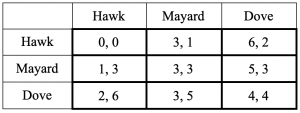Evolutionary Games and Social Norms
How can evolutionary game theory relate to the creation of social norms? Evolutionary games are similar to normal two-person games, the one difference is that for an evolutionary game a player is programmed to play one strategy. John Mayard Smith used game theory to explain animal evolution. He created a new iteration of the Hawk Dove game known as the Hawk, Dove, Mayard’s cuckoo game. Just like the original Hawk Dove Game, Hawk is aggressive while Dove is passive. In Mayard’s game, he adds another strategy for each player, which is known as the Mayard’s cuckoo strategy. The cuckoo is not as aggressive as the Hawk, but more aggressive than the dove. The game is shown in figure (1). In this game, the Mayard cuckoo is immune to invasion from both H and D. Because it is immune from invasion it is known as an Evolutionary Stable Strategy (ESS).
How does this type of game theory relate to how societies have created their own social norms? In normal games, we assume that a player can choose their strategy from all possible strategies. However, in society, there are strategies that we would never consider because of our own social norms. In Baus’ book, he gives the example that a rural Indian woman may choose to wear a red sari but she would never consider wearing something other than a sari. This is known as a Rational-Limiting Norm or a Civil Norm and is defined as a non-empty subset of T of S in which a player may only choose from the subset of T and never S-T. In Baus’ example, S would be all types of clothing, T would be all types of sari, and S-T would be any non-sari clothing.
Now let’s say someone with Civil Norms moved to a new place with different civil norms. Would that society’s Civil Norms stay the same, or would the new norms be adopted into society? An example would be if there is a society in which the Civil Norm is, to be honest, and trustworthy in business practices. Let’s the structure of this game like the Prisoner’s dilemma in which if the players cooperate then they get 1, if one deviates they pick up 2 while the other players get -2, and if both deviates then they both get -1. In this society, the Civil Norm would be to cooperate, and everyone would benefit, thus picking up 1 each. Let’s say a player enters a society that doesn’t have the same Civil Norms and would choose to be untrustworthy and deviate. Would the new norm of betrayal take over or would the trustworthy norm be immune? In this game, the current Civil Norm of trust would be immune from invasion of betrayal. This is what is known as an Evolutionary Stable Norm (ESN). Through the use of game theory analysis, we can see that there is not much difference between natural evolution and social structures.
Source:
Basu, K. (2000). Prelude to political economy. Oxford University Press. https://doi.org/10.1093/0198296711.001.0001

